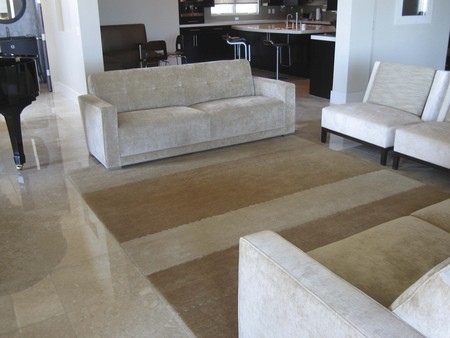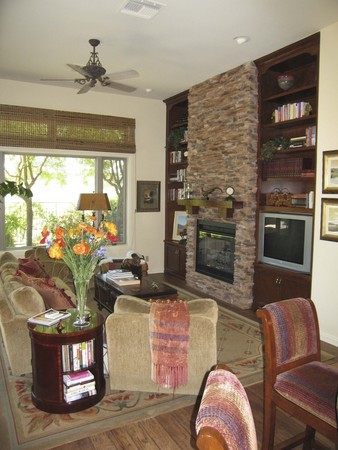What’s underfoot? Flooring options plentiful
While I generally "focus on furniture" in this column, from time to time I feel inclined to branch out and touch on other fundamental aspects of interior design, of which, to be sure, there are many, with flooring being one of the most basic.
When working with clients on a new home or even a remodel, the type of floors to be used is often one of the most essential design elements to be initially considered. I've encountered homeowners who knew exactly what kind of materials they'd be using underfoot, even if they remained undecided as to color or finish. And then there were others who were totally confused as to what material would be best for them -- and why. Finally, there were those who knew what they wanted to use in one space, but not what to do with another. As a designer, it's my job to sort it all out for them, present the pros and cons and lead them out of indecision and onto the right path with the most suitable product.
Judging by the dazzling array of innovative materials and technology available in the marketplace today, I don't think there's ever been a more opportune time (despite our challenging economy) for homeowners to purchase exceptional flooring. Options exist in every conceivable finish and at incredibly diverse price points, so there's indeed something for everyone. And so many of the new materials are not only beautiful to behold, but are wonderfully functional as well. Truly, the best of both words is out there ready for you to pick and choose.
Recently while working with a client, I discovered remarkable porcelain tiles that appear to the eye and even to the touch as wood or leather. I remember thinking how lucky we are to be alive and shopping today with all the incredible products in the marketplace.
When deciding on flooring, the most basic need is to recognize whether your home is contemporary (architectural, sleek and modern, which I equate with the purity and coldness of stone) or more traditional (featuring a lot of wood trims and cabinetry and European-influenced furnishings which calls out for wood flooring). This will no doubt make a difference in the kind of floor covering that will ultimately work best in your surroundings.
And if, like so many of us today, you are a "green" person (those who understand and support the concept of sustainability of the Earth's resources), there are products available to you, such as cork flooring (so cushiony underfoot), as well as bamboo, a personal favorite of mine, and available in an extremely attractive color range.
Along with your preference about what kind of floor covering you might actually like in the various rooms of your home, your budget is obviously a factor to consider.
Naturally, there are pros and cons to all materials.
There are the tried-and-true surfaces of marble, granite, limestone and slate, each with its own inherent properties. Marble is a fairly strong material, but susceptible to staining and can crack and break far more easily than granite. Limestone is versatile and lovely to look at but then again not as strong as marble or granite; and slate, though very attractive, can sometimes slough. When it comes to stone, consumers can go as light or as dark as they choose with these materials.
Personally, I'm inclined to favor wood over stone when I'm working with a more traditional home or want to create a more cozy and relaxed ambience in a room, even within a contemporary space. To my trained eye and sensibility it seems to be the right choice for such a project. But I would point out that tile and stone can be used in either traditional or contemporary design depending on the way they are laid. A clean, straight pattern with very narrow grout will bring to mind contemporary. A brick pattern with wider grout will certainly denote a more classic look. These are some examples of the tricks of the trade. The look and feel of stone and wood floors also can be altered and warmed, or made to appear more cozy, by adding area rugs seasonally when it's cold outside, and then removing them and storing them for the warmer months of the year.
In my experience, most of my clients generally tend to avoid stone in the bedroom(s) and opt for carpeting or certainly at least area rugs over wood and sometimes over stone, but always choosing a softer, more inviting surface for these intimate parts of the home.
Using a stone floor in a warm climate such as ours is always a good idea. It's cool to the touch and resistant to heat and moisture. Still, a hard surface is certainly more tiring if you are constantly standing or walking on it, (i.e., in the kitchen) and, of course, by its very nature, is totally unforgiving to anything that may drop on it.
When and if you decide to use stone, please be sure to take into account that this type of flooring demands a proper weight-bearing subfloor in order to deal with the excess stress that it places upon your home's construction.
Some final thoughts: High-gloss stone can be a little dangerous for traffic but is a glamorous look, nonetheless. Obviously it needs to be avoided in the shower at all costs. Tumbled or honed stone is a much better choice for a surface that is more slip-resistant due to its dull finish. Granite is timeless and a wonderful material, but quite pricey. Don't overlook the option of creating patterns and intricate designs, which can be achieved simply by how the material is laid.
Whatever you decide to do in the way of flooring for your home, don't allow yourself to become overwhelmed by the options that are open to you. Rather be comforted and encouraged by the large variety of materials and costs that are now available.
Stephen Leon is a licensed interior designer and president of Soleil Design International; he has been designing and manufacturing custom furniture and cabinetry for more than 25 years. He has served on the board of directors of the Central California/Nevada Chapter of the American Society of Interior Designers. Questions can be sent to stephen@soleildesigninternational.com.





























